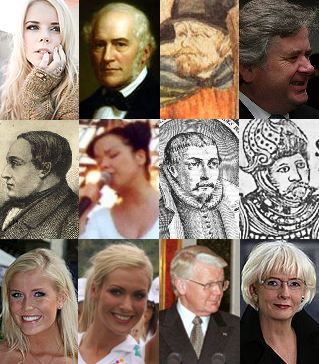Genetic Link Between Creativity and Schizophrenia May Exist
 Genes for creativity may share small if significant links with genes for schizophrenia and bipolar disorder, according to a new Nature Neuroscience study attracting some key accolades this week.
Genes for creativity may share small if significant links with genes for schizophrenia and bipolar disorder, according to a new Nature Neuroscience study attracting some key accolades this week.
Earlier work found evidence of schizophrenia and bipolar disorder among family members of creative types. Epidemiological studies have suggested links between creativity and psychiatric disorders. But few direct links have been found between common genes for creativity, and schizophrenia or bipolar disorder, among artists themselves. The new study, conducted by researchers at deCODE Genetics of Iceland, and King's College London, found that, among 86,292 Icelanders, genetic risk scores for both schizophrenia and bipolar disorder were significantly higher in those defined as creative individuals, with scores halfway between those with the disorders, and the general population.
“This is a fascinating new take on the age-old controversy about whether there is a relationship between mental illness and creativity,” Jordan Smoller, M.D., Sc.D., told Bioscience Technology. Smoller, a Harvard Medical School psychiatry professor, and director of the Massachusetts General Hospital Psychiatric and Neurodevelopmental Genetics Unit, was not involved in the new study.
Read More: Creativity Tied to Cerebellum for First Time
The Nature Neuroscience paper does not provide definitive proof, but it does offer “the most direct evidence to date of a genetic link between creativity and psychosis,” Smoller said.
Sven Cichon, professor of Medical Genetics at University Basel and director of the Division of Medical Genetics at University Hospital Basel, was also uninvolved in the new study. He agreed the proof was not definitive. However, he told Bioscience Technology: “The new paper for the first time presents molecular genetic data that the saying, `There is only a thin line between genius and madness’ may really have biological foundations. The results presented in this paper are very exciting.”
The paper
The film “Love & Mercy,” about the schizoaffective disorder of Beach Boy “genius” Brian Wilson, has been receiving much buzz recently. But Wilson is hardly the first artist to experience a psychiatric disorder.Vincent Van Gogh is thought to have had paranoid schizophrenia. Michelangelo: obsessive compulsive disorder.
For the new study, the teams studied the genetic and medical data of 86,292 Icelanders, looking for a genetic variance that doubled the average risk of schizophrenia, and hiked bipolar risk by one third. There was a 17 percent increase in the variance among members of national arts societies compared with non-members.
When the teams then looked in Netherlands and Swedish medical databases, they found that, among 35,000 people, those defined as creative (via questionnaires, or by profession), were 25 percent more likely to possess the genetic variance.
“Compelling” results
Smoller told Bioscience Technology that earlier studies have suggested there may be an association “between bipolar disorder and creativity in population samples or among groups of artists or scientists. But this study provides the first credible evidence that these two domains are linked at the level of our DNA.”
The British and Icelandic teams applied “an established method for using genomewide DNA variation to examine the overlap between two traits,” Smoller continued. “Mental illnesses are known to be highly polygenic —that is, many hundreds or thousands of DNA variants contribute to risk. They took previously derived genetic risk scores that aggregate the effects of thousands of common DNA variants into a single index of genetic loading for schizophrenia, or bipolar disorder, and found that these scores were significantly associated with the likelihood of being in a creative profession.”
 The study took advantage of a unique population in Iceland, Smoller said, where extensive information about genetic relationships and work history are available among people who have undergone genome-wide genotyping. So the teams “were also able to show that the association was independent of educational attainment, or having a relative with one of the disorders. The results are all the more compelling because they were able to replicate the association in additional, independent samples.”
The study took advantage of a unique population in Iceland, Smoller said, where extensive information about genetic relationships and work history are available among people who have undergone genome-wide genotyping. So the teams “were also able to show that the association was independent of educational attainment, or having a relative with one of the disorders. The results are all the more compelling because they were able to replicate the association in additional, independent samples.”
Precautionary notes
Precautionary notes—musical and otherwise– are being sounded
“It’s important to bear in mind that the genetic overlap between mood or psychotic disorders and creativity was relatively modest,” Smoller told Bioscience Technology. “That is, the genetic risk scores accounted for a small fraction of the variation in their creativity classification. In addition, the use of creative professions is an imperfect measure of an individual’s creativity.”
Furthermore, he said: “There are plenty of unanswered questions. What specific genes or biological pathways might be involved?”
Five back up replication samples
Cichon noted, however, the teams did some difficult, stepwise groundwork. For a long time, “people felt—based on their observations—there might be a link between ‘creativity’ and psychiatric illness, and this was recently supported by epidemiological studies in large population-based cohorts. To find out whether there is a molecular—genetic—basis for this observation, however, is not at all easy. This is what the authors of the paper aimed to do.”
First, he said, the team had to figure out how to measure creativity. “The authors used membership in national artistic societies—actors, dancers, musicians, visual artists and writers—as a `diagnostic tool’ to identify individuals that should be highly creative” in one segment of the work. “Although this is most likely a fuzzy tool, it seems to be good enough to pick up the described effect.”
For a geneticist to have some confidence in a reported association, he continued, “one wishes to see that the identified effect can be replicated in independent study samples. In the present study, there are five replication samples, all of limited size, but relatively consistently showing the same effect. Further independent studies are certainly necessary to further strengthen this finding, but the data presented are sufficiently strong to come to the conclusions made in the paper.”
Furthermore, Cichon said, the study “lets us think about a very exciting research question that researchers ask for complex diseases in general: why are neuropsychiatric disorders so common? For schizophrenia, severely affected individuals appear to have a strong selective disadvantage and fewer offspring. So why do numbers of affected people in the population appear to be stable over long periods of time? One possible explanation is that healthy carriers of schizophrenia risk alleles have some sort of selective advantage that compensates for the selective disadvantage that severely affected individuals have.”
While “creative” types in the present study did not have more children, their numbers may be too small to draw definitive conclusions. Larger studies will have to determine whether a creativity/schizophrenia link explains the evolutionary persistence of some mental disorders.
Cichon noted genomics has made “enormous progress during the past few years, and many genetic risk factors have been identified for a large variety of complex—or multifactorial—diseases. Genetic research will now start looking more into the effects of such risk factors in ‘normal’ individuals, and will aim to find out what effect they possibly have on their phenotype.”
While “exciting,” he said, the new results “remind us we are at the beginning of a long journey to understand the biological mechanisms influenced by genetic factors. Polygenic risk scores are comprised of thousands of genetic variants. They are enriched for phenotype-relevant variants, but also contain neutral genetic variation, or ‘background noise.’ At the moment, it is difficult to definitely identify the phenotype-relevant variants among the variants making up a polygenic risk score. It is also very demanding to determine the often subtle molecular effects mediated by these variants. It involves thorough functional studies in model organisms, cell systems, etc., before we will have a better understanding of the molecular mechanisms that distinguish creative individuals from un-creative, and from individuals with schizophrenia or bipolar disorder.”
Much, much caution
University of Bologna psychiatrist/geneticist Alessandro Serretti, M.D., Ph.D., has some larger concerns. Serretti, director of the University of Bologna’s Unit for Mood and Anxiety Disorders, was also uninvolved in the new study.
“The paper is from a well-known group of scientists. The genetic analysis methods are very good, and indeed they replicate the original findings on independent populations with positive results,” he told Bioscience Technology. “So overall, it is a convincing evidence for some common genetic background between psychoses and creativity.”
However, he said: “Much, much caution should be used in interpreting results. First, the risk values for shared genetic background, though significant, are very far from relevant. The contribution is really minimal, leaving 99 percent of the basis of creativity out of this explanation.”
Secondly, he said, the paper’s definition of creativity “is a proxy at best: ‘Phenotypes: Creative professionals were defined as those having (or ever having had, where lifetime data were available) positions in the fields of dance, film, music, theater, visual arts or writing. Those teaching these subjects at the secondary level or above were also included.’”
This does not take into consideration, he said, the fact that such people must possesses “a number of features to work in those fields, such as management skills, physical features and so on.”
As such, any next step in this area of research, Serretti told Bioscience Technology, may prove “troublesome. If genetics may explain such a low part of the phenomenon, more detailed interviews with huge sample sizes are not realistic. Probably more convergent and comprehensive explanatory models should be used, such as complex ‘gene x’ environment interactions. But this step requires a degree of creativity indeed that has not appeared yet in the scientific landscape.”
Response
In response, first author Robert Power, Ph.D., told Bioscience Technology that “one limitation of our study is that the genetics of schizophrenia and bipolar disorder is still poorly understood. For example, while we know they are highly heritable, known genetic risk variants only explain two percent of risk. So looking for an overlap with creativity is limited by this.”
But, said Power, who is with the Institute of Psychiatry, Psychology & Neuroscience at King’s College, “while the predictive value is very small currently, it suggests a significant genetic overlap between the two.”
Power did agree, however, that “our definition of creativity by career is a proxy.” He also finds the idea of “diseases such as schizophrenia and bipolar disorder being the unintended side effects of selection for humans to evolve traits like creativity” to be “an exciting one,” if “evidence is lacking at this point. Creativity, at least in today's society, doesn't appear to increase the number of children someone has.”
On the other hand, he told Bioscience Technology: “Perhaps this might have been different at other stages of human history.”

